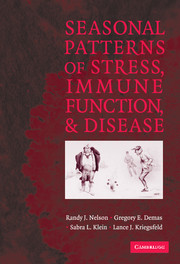Book contents
- Frontmatter
- Contents
- Acknowledgments
- Foreword
- Preface
- 1 Seasonality
- 2 Immune Function
- 3 Seasonal Fluctuations in Disease Prevalence
- 4 Seasonal Changes in Immune Function
- 5 Photoperiod, Melatonin, and Immunity
- 6 Energetics and Immune Function
- 7 Hormonal Influence on Immune Function
- 8 Clinical Significance of Seasonal Patterns of Immune Function and Disease
- References
- Index
1 - Seasonality
Published online by Cambridge University Press: 11 November 2009
- Frontmatter
- Contents
- Acknowledgments
- Foreword
- Preface
- 1 Seasonality
- 2 Immune Function
- 3 Seasonal Fluctuations in Disease Prevalence
- 4 Seasonal Changes in Immune Function
- 5 Photoperiod, Melatonin, and Immunity
- 6 Energetics and Immune Function
- 7 Hormonal Influence on Immune Function
- 8 Clinical Significance of Seasonal Patterns of Immune Function and Disease
- References
- Index
Summary
Live in each season as it passes; breathe the air, drink the drink, taste the fruit, and resign yourself to the influences of each. Let them be your only diet, drink, and botanical medicine.
Henry David Thoreau, 1906 Journals (entry for 23 August 1853)Introduction
Life on Earth evolves in an environment with pronounced temporal fluctuations. Rivers flow to the sea; the tides ebb and rise. Light availability and temperature vary predictably throughout each day and across the seasons. These fluctuations in environmental factors exert dramatic effects on biotic activities. For example, the biochemical machinery of plants and animals undergoes daily adjustments in production, performing some processes only at night and others only during the day. Similarly, daily peaks in the metabolic activity of homeothermic animals tend to coincide with the daily onset of increased physical activity. Elevated activity alone does not drive metabolic rates; rather, the general pattern of metabolic needs are anticipated by reference to an internal biological clock. The ability to anticipate the onset of the daily light and dark periods confers sufficient advantages that endogenous, self-sustained circadian clocks are virtually ubiquitous among extant organisms (Takahashi 1996; Menaker et al. 1997).
In addition to synchronizing biochemical, physiological, and behavioral activities to the external environment, biological clocks are important to multicellular organisms in synchronizing internal processes. If a specific biochemical process is most efficiently conducted in the dark, then individuals that mobilize metabolic precursors, enzymes, and energy sources just prior to the onset of dark would presumably have a selective advantage over individuals that organized their internal processes at random times.
- Type
- Chapter
- Information
- Publisher: Cambridge University PressPrint publication year: 2002

